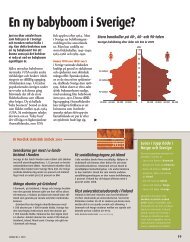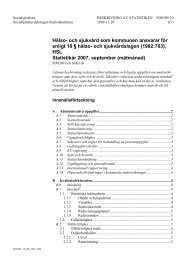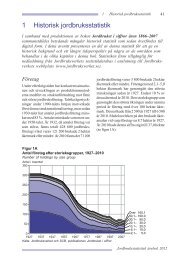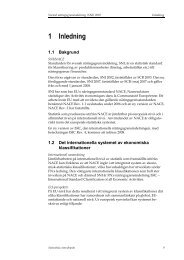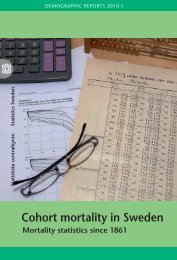Perspektiv på välfärden 2004 (pdf) - Statistiska centralbyrån
Perspektiv på välfärden 2004 (pdf) - Statistiska centralbyrån
Perspektiv på välfärden 2004 (pdf) - Statistiska centralbyrån
Create successful ePaper yourself
Turn your PDF publications into a flip-book with our unique Google optimized e-Paper software.
departs from the indicators that make up the deprivation<br />
index, because it is not only dependent on<br />
the respondents' interpretation of the situation, but<br />
also on the fact that the situation has been evaluated<br />
and that need for assistance has been confirmed.<br />
Interpreting today from the rear view<br />
The availability of longitudinal data represents a<br />
great step forward for youth research, enabling<br />
analysis of the long-term impact of conditions<br />
during youth. However, longitudinal data have<br />
one serious drawback, especially if they cover a<br />
relatively long time span; they tempt us to draw<br />
conclusions about today’s society based on conditions<br />
that prevailed during an earlier period. To<br />
mitigate this problem of relevancy, one strategy,<br />
which is used here, is to base the analysis on aspects<br />
that repeatedly, and over a long period of<br />
time, have been shown to be important for the<br />
structure of economic rewards and living conditions.<br />
Another strategy is to place the analysis in a<br />
historical context, comparing the conditions in<br />
‘our’ cohort with the situation among today’s<br />
youth. 0Because ULF is an ongoing survey program,<br />
a number of variables can be utilized in<br />
time series. Figure 2 displays the difference in<br />
unemployment, employment, lack of cash margin<br />
and social assistance between 19- to 25-year-olds<br />
and 35- to 41-year-olds between 1975 and 2001<br />
(for social assistance 1983-2000). The young<br />
group match our panel sample at t 0 , while the<br />
older group is the same age as our panel sample at<br />
t 2. As expected, the younger group is worse off<br />
compared to the middle aged, but they follow the<br />
same development and the ratio between the<br />
groups is stable or in fact somewhat declining<br />
over time. Deviating from this pattern is the employment<br />
rate, such that the relative difference<br />
between the age groups increases. However, this<br />
increase is not related primarily to unemployment,<br />
but to prolonged education among the young. It is<br />
clear from Figure 2 that the recession in the 1990s<br />
affected the situation for the young, but there is<br />
nothing to indicate that the situation in the beginning<br />
of the new millennium is dramatically worse<br />
than it was 20 years ago.<br />
Surveys are always affected by non-responses,<br />
which is problematic when one suspects covariation<br />
between non-responses and the key issue to<br />
be investigated. It is, for example, reasonable to<br />
expect that non-responses will be relatively common<br />
among the poorest and most marginalized<br />
section of the population. Hence, we can assume,<br />
in the context of this study, that we underestimate<br />
surveys reveals that the question underreports the ex-<br />
tent of social assistance.<br />
Youth<br />
the extent to which young people suffer from<br />
economic hardship. The problem is exaggerated<br />
when longitudinal data are utilized, as we can also<br />
assume a similar bias as regards panel attrition.<br />
Because ULF uses a mix between a panel sample<br />
and a cross-sectional sample, we can actually<br />
analyse the degree to which our panel is affected<br />
by attrition. Table 1 displays mean values not<br />
only for the panel sample, but also for an age- and<br />
year-matched cross-sectional sample. Here we can<br />
see that the panel sample is somewhat wealthier<br />
and less deprived compare to a cross-sectional<br />
sample. A comparison between the panel and<br />
cross-sectional data is also made in table1, revealing<br />
the same pattern. Higher education is significantly<br />
more common in the panel, while nest<br />
leaving, parenthood and social assistance are<br />
more frequent in the cross-sectional sample.<br />
Hence, it can be concluded that the panel sample<br />
will display a more favourable picture of the<br />
youth situation compared with the cross-sectional<br />
sample, which, in turn, is probably underestimating<br />
the incidence of problems from the outset.<br />
Method<br />
To analyse our data, a so-called growth model has<br />
been estimated (cf. Halleröd and Gustafsson<br />
2003; McArdle 1988; Meredith and Tisak 1990;<br />
Muthén and Khoo 1998; Rogosa, Brandt and Zimowski<br />
1982). The basic idea of growth modelling<br />
is to describe trajectories over time in terms<br />
of parsimonious models. Using a structural equation<br />
(SEM) framework, a latent variable is identified<br />
through its relations to multiple observed<br />
variables. The approach has several advantages.<br />
The latent variable is not influenced by random<br />
errors of measurement, separating actual change<br />
from measurement errors. It allows formulation of<br />
structural models, in which a particular assumed<br />
pattern of influences among variables is tested<br />
against empirical data (Hoyle 1995).<br />
In the latent variable approach, the estimation<br />
problem is to determine the parameters of the<br />
distribution, i.e., mean and variance for a normal<br />
distribution. In a linear growth model, one latent<br />
variable represents individual differences in intercept<br />
parameters, while another latent variable<br />
represents individual differences in slope parameters.<br />
The estimation of a growth model from three<br />
observations of income includes two latent variables:<br />
Intercept and Slope. The Intercept variable<br />
represents individual differences in income at t 0<br />
and has a fixed relation of unity to all three manifest<br />
variables (i.e., observed income at t 0, t 1, and t 2) .<br />
The Slope variabl0e represents individual differences<br />
in change in income over time. In a linear<br />
model, the Slope variable has a fixed relation of 0<br />
with the t 0 measure, of 1 with the t 1 measure, and<br />
of 2 with the t 2 measure, expressing the assump-<br />
73




